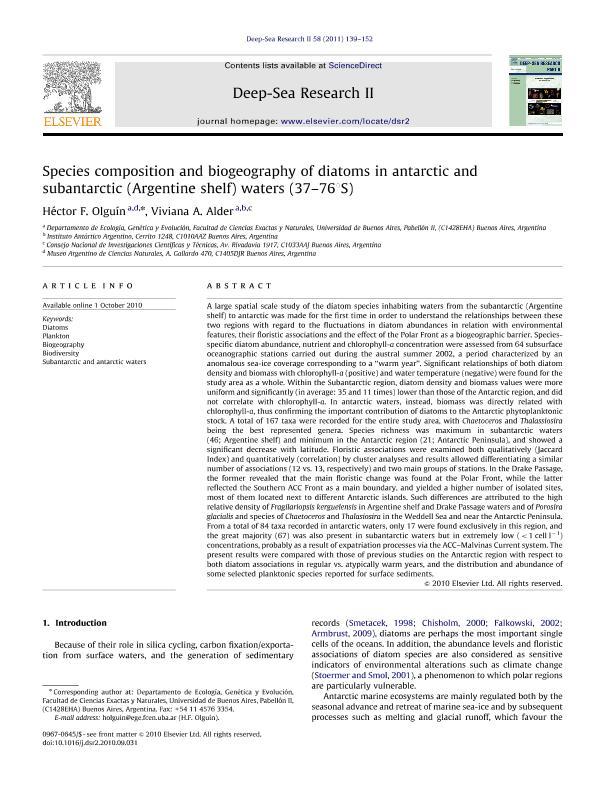Artículo
Species composition and biogeography of diatoms in antarctic and subantarctic (Argentine shelf) waters (37-76°S)
Fecha de publicación:
01/2011
Editorial:
Pergamon-Elsevier Science Ltd
Revista:
Deep Sea Research Part II: Topical Studies in Oceanography
ISSN:
0967-0645
Idioma:
Inglés
Tipo de recurso:
Artículo publicado
Clasificación temática:
Resumen
A large spatial scale study of the diatom species inhabiting waters from the subantarctic (Argentine shelf) to antarctic was made for the first time in order to understand the relationships between these two regions with regard to the fluctuations in diatom abundances in relation with environmental features, their floristic associations and the effect of the Polar Front as a biogeographic barrier. Species-specific diatom abundance, nutrient and chlorophyll-a concentration were assessed from 64 subsurface oceanographic stations carried out during the austral summer 2002, a period characterized by an anomalous sea-ice coverage corresponding to a "warm year". Significant relationships of both diatom density and biomass with chlorophyll-a (positive) and water temperature (negative) were found for the study area as a whole. Within the Subantarctic region, diatom density and biomass values were more uniform and significantly (in average: 35 and 11 times) lower than those of the Antarctic region, and did not correlate with chlorophyll-a. In antarctic waters, instead, biomass was directly related with chlorophyll-a, thus confirming the important contribution of diatoms to the Antarctic phytoplanktonic stock. A total of 167 taxa were recorded for the entire study area, with Chaetoceros and Thalassiosira being the best represented genera. Species richness was maximum in subantarctic waters (46; Argentine shelf) and minimum in the Antarctic region (21; Antarctic Peninsula), and showed a significant decrease with latitude. Floristic associations were examined both qualitatively (Jaccard Index) and quantitatively (correlation) by cluster analyses and results allowed differentiating a similar number of associations (12 vs. 13, respectively) and two main groups of stations. In the Drake Passage, the former revealed that the main floristic change was found at the Polar Front, while the latter reflected the Southern ACC Front as a main boundary, and yielded a higher number of isolated sites, most of them located next to different Antarctic islands. Such differences are attributed to the high relative density of Fragilariopsis kerguelensis in Argentine shelf and Drake Passage waters and of Porosira glacialis and species of Chaetoceros and Thalasiosira in the Weddell Sea and near the Antarctic Peninsula. From a total of 84 taxa recorded in antarctic waters, only 17 were found exclusively in this region, and the great majority (67) was also present in subantarctic waters but in extremely low (<1celll-1) concentrations, probably as a result of expatriation processes via the ACC-Malvinas Current system. The present results were compared with those of previous studies on the Antarctic region with respect to both diatom associations in regular vs. atypically warm years, and the distribution and abundance of some selected planktonic species reported for surface sediments.
Palabras clave:
BIODIVERSITY
,
BIOGEOGRAPHY
,
DIATOMS
,
PLANKTON
,
SUBANTARCTIC AND ANTARCTIC WATERS
Archivos asociados
Licencia
Identificadores
Colecciones
Articulos(MACNBR)
Articulos de MUSEO ARG.DE CS.NAT "BERNARDINO RIVADAVIA"
Articulos de MUSEO ARG.DE CS.NAT "BERNARDINO RIVADAVIA"
Articulos(SEDE CENTRAL)
Articulos de SEDE CENTRAL
Articulos de SEDE CENTRAL
Citación
Olguin Salinas, Hector; Alder, Viviana Andrea; Species composition and biogeography of diatoms in antarctic and subantarctic (Argentine shelf) waters (37-76°S); Pergamon-Elsevier Science Ltd; Deep Sea Research Part II: Topical Studies in Oceanography; 58; 1-2; 1-2011; 139-152
Compartir
Altmétricas




